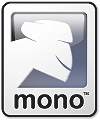 Working on software that runs on multiple machines can be time consuming, error
prone, and complicated. Not only do each of the three major operating
systems have different style guidelines, but they even have different
standard programming languages. Mac OS X has Objective C and
Cocoa, Windows has
.NET and
WPF, and Linux
has C/C++ and GTK+ or KDE.
No wonder cross platform applications look so out of place. However, as
unlikely as it may seem, .NET may be the best solution to the native
looking cross platform problem.
Working on software that runs on multiple machines can be time consuming, error
prone, and complicated. Not only do each of the three major operating
systems have different style guidelines, but they even have different
standard programming languages. Mac OS X has Objective C and
Cocoa, Windows has
.NET and
WPF, and Linux
has C/C++ and GTK+ or KDE.
No wonder cross platform applications look so out of place. However, as
unlikely as it may seem, .NET may be the best solution to the native
looking cross platform problem.
Java, what could have been
Java was supposed to be the solution to making your applications work across multiple platforms. While the “write once, run anywhere” slogan is quite accurate, you can easily pick out a java application on every desktop platform. Java currently uses its own UI framework named Swing. The problem is that to make sure that applications run properly on all the platforms, swing does not follow any of the UI standards set by Windows, Mac OS X, GTK, or KDE. It also does its own software based drawing of all its widgets. Because of this, Java has gotten a reputation for being slow and laggy. The language is quite fast, keeping up with .NET and in a close race with C/C++, but the UI has really held it back.
Qt, the C++ solution
The Qt framework, by Nokia (previously Trolltech), is an impressive cross platform C++ framework that tries to solve some of the same things Java set out to do, but using the tried and true C++ language. I’ve used Qt since somewhere around version 2, and I’ve found that for a C++ developer, Qt is quote an impressive framework. Nokia has also put together an IDE specifically for Qt which inclues code completion which has been difficult in the past due to Qt’s precompiler.
Also, Qt is another framework that does its own widget drawing, but has the added benefit of supporting hardware acceleration. This makes Qt’s widget drawing to be as fast or faster than native widgets. If you don’t use the hardware acceleration for whatever reason, the Qt “trolls” have optimized the heck out of their drawing code. They also have different skins for the different operating systems to make the widgets look native, however don’t expect all widgets to be there or look 100% the same. All in all, if you know and like C++, Qt may be a decent solution.
One of the problems with Qt is that it’s built on C++. While I’m a C++ fan, the development time for anything is dramatically increased. C++ is verbose in general because of the header/source files, sometimes making it feel like you are writing twice the amount of code. C++ compilers are also slow due to complicated syntax rules and C++ template generation. This makes development slow compared to some of the snappier compilers for other languages. You also have to take into account compiling a different executable on every platform. Since the executable code is not run within a virtual machine, it needs to take into account the differences between platforms itself.
Mono and .NET
You wouldn’t realize that .NET is a cross platform solution by looking at Microsoft’s website. That’s because to Microsoft, .NET is for the Windows operating system. You have to look to a smaller company, Xamarin, and the Mono community to find that they have developed a fairly complete and production ready .NET implementation over the past seven years. They’ve also created a fairly good IDE for Mono called MonoDevelop.
So why is .NET and Mono the better solution? Well, you get the power of the .NET framework of course. Mono currently supports up to .NET 4.0 with some features of 5.0 already working in the trunk. The .NET compilers are also quite fast during compilation out of the box giving you major speed boosts over C++. You also get WinForms support out of the box. That will give you native rendering in Windows with mimicked results on the other operating systems. Of course, this is only a starting point. Mono supports a multitude of other UI frameworks including Gtk and Cocoa, giving you true native drawing in all platforms. There’s even MonoTouch, Mono for Android, and Windows Phone 7 frameworks to cover the mobile side.
The one issue you have when you jump to multiple frameworks, though, is that you require multiple UI projects for the same solution. This will be the downside of any project that will try to be native on multiple platforms, no matter what the language. You can start developing using WinForms and have a workable solution for all platforms. Later when you want to add true native support, you can add in WPF, MonoMac, and GtkSharp. At that point, it’s up to you which frameworks to support with no limitations.